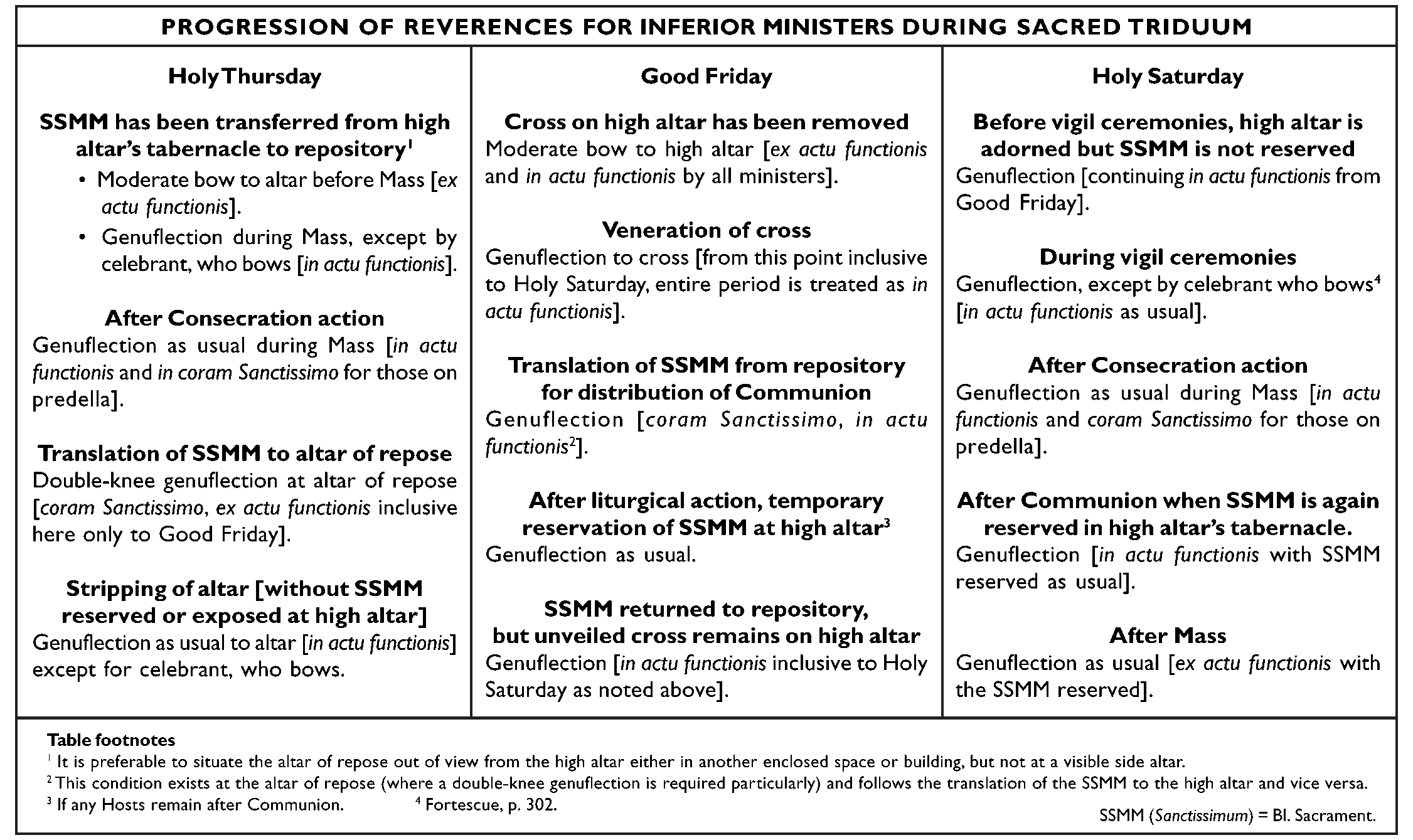"Should I Genuflect?"
What to do during the Sacred Triduum
The last three and holiest days of Holy Week, called the Sacred Triduum, offer some of the Church’s most venerable, symbolic and profound rites to re-present the blessed Passion and saving Triumph of Our Lord Jesus Christ.
Ancient practices witnessed
The varied and rich ceremonies of the Sacred Triduum (i.e., Holy Thursday, Good Friday and Holy Saturday) also offer some views into past liturgical customs once commonly practiced in the Roman Rite.
Two examples from Holy Thursday and Good Friday are:
1. The ancient method of distributing Holy Communion to the faithful: this is actually witnessed in reverse, as the bringing (procession) of the Blessed Sacrament to the altar by the deacon is done on Good Friday, while the returning (Translation) of the Eucharist to Its place of reservation (altar of repose) occurs on Holy Thursday.
Beyond the historical allusion of the Translation on Maundy Thursday, today it symbolically recalls Our Lord being led to the Garden of Gethsemane, where we are invited to spend some time with Him in contemplation of His forthcoming Passion until midnight.
2. The vesting and stripping of the altar: again this venerable practice is seen on the same opposite days, with the gradual vesting taking place during the Solemn Afternoon Liturgy of Good Friday, while the denuding of the altar takes place during the Dividunt of Holy Thursday after the Translation.
In ancient times, the altar was ceremonially divested after every offering of the Holy Sacrifice, a practice that continues to be observed in the Roman basilicas, but after the liturgical services (and it should be noted that these are the only places where this custom is still allowed, as liturgical law requires that the altar should always be vested).
Today, the stripping of the altar signifies the act of humiliation enacted upon Our Savior by the soldiers when they removed His garments— this denuding of the altar is even more striking if the high altar is typically vested with an antependium throughout the year, thus the faithful are more accustomed to seeing the sacrificial rock that represents Christ arrayed in kingly splendor, rather than in stony nakedness. (cf. The Liturgical Altar for details as well as Candles in the Roman Rite for some beautifully illustrated examples).
Varied Roman Rite reverences presented
The ceremonies of Holy Week also present the opportunity to witness every type of reverence used in the Roman Rite, from the simple bow, to a double-knee genuflection, to the full prostration, seldom seen except at ordinations or the taking of religious vows in some religious orders.
The various circumstances (or liturgical conditions) in the church during the Sacred Triduum changes from day to day and even within the ceremonies themselves which affects what type of reverence should be made as well as to what (the Blessed Sacrament, altar, cross, etc.). These transitions often are a source of confusion for the laity (and even the clergy), who are usually unacquainted with the general principles that govern when, how and why they should genuflect or bow, let alone to what in the sanctuary.
“Should I genuflect?” A free reference card!
In an attempt to aid the faithful in this regards, I have excerpted the table, Progression of Reverences for Inferior Ministers during Sacred Triduum from my book, The General Principles of the Roman Rite (For Inferior Ministers). Though this work was compiled primarily for altar servers, it is also a good resource for both the laity and clergy, as demonstrated by the table—the directions of which are the same rules that the clergy attending in choir (i.e., in the sanctuary) observe and which likewise apply to the laity in the nave.
This Progression of Reverences table has been made available for free as a printable card and is formatted to be printed on letter-size paper and then trimmed down to fit into most daily missals—thus serving as a handy reference during the entire Sacred Triduum.
Romanitas—governing principle of the Roman Rite
It bears repeating (as explained in General Principles) that our liturgical rite is called “Roman” not just because it originated in the Holy City of that name, but more importantly, because it engenders that great spirit of Romanitas, which means to have a Roman mentality.
The two pillars of Romanitas are logic and practicality. Thus the various reverences that we make as Roman Catholics are done because they make sense, while also being practical. In fact, a close examination of the Progression of Reverences Table will distinctively reveal this underlying character of Romanitas in our venerable rite being applied in a special manner throughout the Sacred Triduum.
Intelligent adoration of God
Lastly, our devotion (and thus adoration of God) is intelligently manifested when we pay attention to our surroundings (i.e., in the sanctuary) and make the appropriate reverence as a deliberate act of worship, rather than merely “genuflecting on auto-pilot”. Thus this attention to detail can also further assist to more intimately and profoundly join our hearts and minds to the blessed Passion of Our Lord and Savior, by simply and consciously wishing to conform our wills to the spirit, mindset and thus the Roman Church’s liturgical discipline.
In relation to this point, I wholeheartedly recommend the excellent and comprehensive article of Fr. Michael Simoulin, Attendance and Participation at Mass, published originally in the March 1997 issue of The Angelus magazine.








